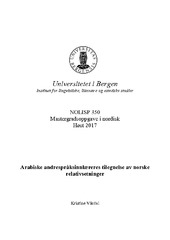| dc.contributor.author | Vårdal, Kristine | |
| dc.date.accessioned | 2017-10-05T06:44:30Z | |
| dc.date.available | 2017-10-05T06:44:30Z | |
| dc.date.issued | 2017-10-03 | |
| dc.date.submitted | 2017-10-02T22:00:02Z | |
| dc.identifier.uri | https://hdl.handle.net/1956/16740 | |
| dc.description.abstract | Denne avhandlingen undersøker hvordan andrespråksinnlærere med arabisk som morsmål (S1) tilegner seg relativsetninger i norsk (S2). På grunnlag av bruksbasert teori og internasjonal forskning på relativsetninger gjøres det fire prediksjoner om arabiske innlæreres tilegnelse av norske relativsetninger: I. De arabiske innlærernes performanse på relativsetninger vil variere ut ifra relativiseringsleddets grammatiske funksjon i relativsetningen, nærmere bestemt ut ifra hvor frekvente og komplekse relativiseringer av ulike funksjoner er i målspråket (norsk). II. De arabiske innlærerne kommer til å omforme infrekvente og komplekse relativiseringer i målspråket (norsk) til frekvente og enkle relativiseringer. III. De arabiske innlærerne kommer til å bruke pronomenkopier, og bruken vil variere i tråd med relativiseringenes frekvens og kompleksitet i målspråket (norsk) og/eller i kildespråket (arabisk). IV. De arabiske innlærernes performanse på relativsetninger vil også variere ut ifra korrelatets grammatiske funksjon i oversetningen, nærmere bestemt ut ifra hvor frekvente og komplekse modifiseringer av ulike funksjoner er i målspråket (norsk). To typer data analyseres. Den første typen består av svarene til ni arabiske innlærere, to engelske innlærere og to morsmålsbrukere på en friproduksjonsoppgave og en setningskombinasjonsoppgave. Den andre typen består av frekvensdata fra tre norske korpus: Norsk talespråkskorpus, Leksikografisk bokmålskorpus og NorGramBank. Resultatene viser at prediksjonene bekreftes: Performansen til de arabiske innlærerne (og de engelske innlærerne og morsmålsbrukerne) varierer i tråd med relativsetningenes frekvens og kompleksitet i norsk slik det fremkommer av mine analyser. Funnene støtter derfor opp under bruksbasert teori sin hypotese om språklig ontogenese som sier at den primære faktoren som driver språklæring og -bruk, er språkbrukernes erfaringer med konstruksjonene i språket. Resultatene tyder imidlertid også på mulig transfer fra innlærernes S1 siden de arabiske innlærerne gjør flere feil enn de andre informantene, spesielt pronomenkopifeil. Siden prediksjonene bekreftes, argumenteres det i diskusjonen for at en av de mest innflytelsesrike hypotesene i tidligere internasjonal forskning på relativsetninger, den typologiske markerthetshypotesen, verken kan predikere eller forklare de arabiske innlærernes performanse på norske relativsetninger. | en_US |
| dc.description.abstract | This thesis investigates how Arabic second language learners of Norwegian acquire Norwegian relative clauses. Based on usage-based theory and international research on the acquisition of relative clauses, four predictions about Arabic learners’ acquisition of Norwegian relative clauses are made: I. The Arabic learners’ performance on relative clauses will vary with the relativized syntactic role, more specifically with the frequency and complexity of the relativized syntactic role in the target language (Norwegian). II. The Arabic learners will convert infrequent and complex relatives in the target language (Norwegian) into frequent and simple relatives. III. The Arabic learners will use resumptive pronouns, and the use will vary with the frequency and complexity of the relativized syntactic role in the target language (Norwegian) and/or in the source language (Arabic). IV. The Arabic learners’ performance on relative clauses will also vary with the head’s syntactic role in the main clause, more specifically with the frequency and complexity of the head’s syntactic role in the target language (Norwegian). Two types of data were analyzed. The first type consists of the answers of nine Arabic learners, two English learners and two native speakers on a free production task and a sentence-combining task. The second type consists of frequency data from three Norwegian corpora: Norsk talespråkskorpus, Leksikografisk bokmålskorpus and NorGramBank. The results confirm the predictions: The performance of the Arabic learners (and the English learners and native speakers) vary with the frequency and complexity of Norwegian relative clauses as estimated in my analyzes. The findings therefore support the usage-based hypothesis about linguistic ontogenesis saying that the major driving force of language acquisition and use, are the constructions of the language and the learner’s experience of these constructions. In addition, the results indicate possible transfer from the learners’ L1, as the Arabic learners make more errors than the other informants, especially resumptive pronoun errors. Since the predictions are confirmed, it is argued in the discussion that one of the most influential hypotheses in previous international research on relative clauses, the typological markedness hypothesis, neither can predict nor explain the Arabic learners’ performance on Norwegian relative clauses. | en_US |
| dc.language.iso | nob | eng |
| dc.publisher | The University of Bergen | eng |
| dc.subject | tilegnelse av relativsetninger | eng |
| dc.subject | tilgjengelighetshierarkiet | eng |
| dc.subject | arabiske innlærere | eng |
| dc.subject | bruksbasert teori | eng |
| dc.title | Arabiske andrespråksinnlæreres tilegnelse av norske relativsetninger | eng |
| dc.title.alternative | Arabic second language learners' acquisition of Norwegian relative clauses | eng |
| dc.type | Master thesis | |
| dc.date.updated | 2017-10-02T22:00:02Z | |
| dc.rights.holder | Copyright the Author. All rights reserved | eng |
| dc.description.degree | Mastergradsoppgave i nordisk | |
| dc.description.localcode | NOLISP350 | |
| dc.subject.nus | 711123 | eng |
| fs.subjectcode | NOLISP350 | |
| fs.unitcode | 11-21-00 | |
